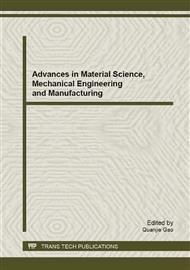p.311
p.315
p.319
p.323
p.329
p.334
p.339
p.345
p.349
Study of Direct Quenching and Tempering Process of a Low Carbon Equivalent 960 MPa Grade Steel
Abstract:
The chemical composition of a 960 Mpa grade high strength steel with low carbon equivalent was designed. Effect of direct quenching and tempering process on the microstructure and mechanical properties of the experimental steel was studied. Results showed that fine lath martensite was obtained after controlled rolling and direct quenching. With tempering temperature increasing, the mechanical properties showed different trends for different tempering stages. And this had a direct relationship with the microstructure evolution. The matrix recovery softening, carbon desolution and precipitation of nanomicroalloy carbides influenced the strength change. With increase of tempering time, the strength decreased and toughness improved. Experimental steel tempered at 450 °C for 40min could obtain the best mechanical properties, which meet the requirement with a large impact energy margin.
Info:
Periodical:
Pages:
329-333
Citation:
Online since:
August 2013
Authors:
Price:
Сopyright:
© 2013 Trans Tech Publications Ltd. All Rights Reserved
Share:
Citation:


